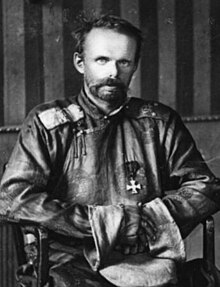This is an old revision of this page, as edited by 24.68.130.206 (talk) at 18:34, 23 July 2005. The present address (URL) is a permanent link to this revision, which may differ significantly from the current revision.
Revision as of 18:34, 23 July 2005 by 24.68.130.206 (talk)(diff) ← Previous revision | Latest revision (diff) | Newer revision → (diff)
Baron Roman Nicolaus Fyodorovich von Ungern-Sternberg (Russian Роман Фёдорович Унгерн фон Штернберг) (January 22, 1886, new style — September 15, 1921) a.k.a. Bloody Baron, lieutenent-general, one of the military commanders on the side of the White movement during the Russian Civil War, later an independent warlord in pursuit of pan-monarchist goals in Mongolia and territories east of Lake Baikal.
Ungern-Sternberg was born on the island of Dago, Russian Empire (now Hiiu County, Estonia), the family is Baltic Germannobility. He graduated from Pavlovsk Military School and participated in World War I. Before 1914, Ungern-Sternberg had served in Siberia where he was enthralled with the life-style of nomadic peoples such as the Mongols and Buryats. During World War I, Ungern-Sternberg fought in Galicia. During the war, he was considered a very brave, but a somewhat reckless and mentally unstable officer. After the February 1917 revolution he was sent by the Provisional Government to the Russian Far East under command of Grigory Mikhailovich Semenov to establish a loyal military presence there.
In the aftermath of the Bolshevik take-over in November 1917, Semenov and his right-hand man, Ungern-Sternberg raised their banners against them. In the following months Ungern-Sternberg distingushed himself by extreme cruelty to the local population and to his own subordinates. He earned the nickname Bloody Baron. Ungern-Sternberg was also known as the "Mad Baron" because of his exceedingly eccentric behavior. Semenov and Ungern-Sternberg, through anti-Bolshevik, were not part of the White movement, and declined to recognize the authority of Admiral Aleksandr Kolchak, the nominal leader of the Whites. Instead, they were supported by the Japanese with arms and money. The Japanese intention was to found a puppet state in the Russian Far East headed by Semenov. For the White leaders, who believed in "Russia strong and indivisable", this was high treason. Furthermore, Ungern-Sternberg's co-operation with the despised Japanese did not help matters. Ungern-Sternberg’s army comprised a mixture of Russian troops, the Transbaikal Cossack Host, and Buryat tribesmen who just as often plundered White supply trains as they did Red. Because Admiral Kolchak had his base of operations in central Siberia, and Semenov and Ungern-Sternberg operated to the east of Kolchak in Transbaikal area, their attacks on supply trains travelling west from Vladivostok on the Trans-Siberian Railroad did much to hinder Kolchak's operations in the Urals.
In 1920 he split from Semenov and became an independent warlord. He believed that the monarchy was the only social system which could save Western civilization from corruption and self-destruction. He began to pursue an idea of restoring the Qing Dynasty to the Chinese throne, then uniting Far-Eastern nations under it. A fanatical anti-semite, he proclaimed in a 1918 Manifesto, his intention "...to exterminate all of the Jews and Commissars of Russia" and to restore the recently executed Grand Duke Mikhail, the younger brother of Nicholas II to the Russian throne. Ungern-Sternberg's men slaughtered Jews whenever they encountered them, often in a variety of barbarous ways such as skinning them alive. Because of the disruptions caused by World War One, the Pale of Settlement where Jews have been forced to live prior to the war had broken down, and many Jews had fled eastwards to escape the fighting.
Since 1919 Mongolia was occupied by Chinese republican forces. In late 1920-early 1921 Ungern's troops entered Mongolia at the invitation of the displaced Bogdo Khan (Bogdo Gegen, Bogd Haan), Mongolia's civil and religious ruler. In January 1921, Ungern-Sternberg's army assaulted the capital of Urga several times, but were repulsed with heavy losses. Ungern-Sternberg ordered his troops to burn a large number of camp fires in the hills around the capital town Urga, making an appearance that the town was surrounded by an overwhelming force. In February 1921, without fighting a battle, he drove the Chinese out of town. On March 13 Mongolia proclaimed itself an independent monarchy. Ungern-Sternberg became Mongolian dictator. A mystic who was fascinated by beliefs and religions of the Far East such as Buddhism and who believed himself to be a reincarnation of Genghis Khan , Ungern-Sternberg's philosophy was an exceptionally muddled mixture of Russian nationalism with Chinese and Mongol beliefs. His brief rule of Mongolia was charactized by much looting and an reign of terror by his army.
A Red Army force send to deal with Ungern-Sternberg (Pro-Soviet Mongolian leader Suhbaatar (Sukhe-Bator)) defeated Ungern-Sternberg's forces in Mongolia. In May, Ungern-Sternberg attempted to invade Soviet territory near Troitskosavsk (now Kyakhta, Buryatia). After initial successes in May and June, Ungern-Sternberg was defeated in a July-August counteroffensive, captured by his own soldiers, and given to the Red Army on August 21, 1921.
After a quick military tribunal Ungern was executed by a firing squad in Novonikolayevsk (now Novosibirsk, Russia).
Ungern-Sternberg was declared to be a Mahakala incarnation by the Dalai Lama XII.
Literature
- Alioshin, Dimitri: Asian Odyssey, New York 1941.
- Hopkirk, Peter: Setting the East Ablaze : On Secret Service in Bolshevik Asia, Don Mills 1986.
- Ossendowski, Ferdynand: Beasts, Men And Gods, New York 1922.